|
||||||||||||||||||||||
![Home - Air Power Australia Website [Click for more ...]](APA/APA-Title-Main.png) |
||||||||||||||||||||||
![Sukhoi PAK-FA and Flanker Index Page [Click for more ...]](APA/flanker.png) |
![F-35 Joint Strike Fighter Index Page [Click for more ...]](APA/jsf.png) |
![Weapons Technology Index Page [Click for more ...]](APA/weps.png) |
![News and Media Related Material Index Page [Click for more ...]](APA/media.png) |
|||||||||||||||||||
![Surface to Air Missile Systems / Integrated Air Defence Systems Index Page [Click for more ...]](APA/sams-iads.png) |
![Ballistic Missiles and Missile Defence Page [Click for more ...]](APA/msls-bmd.png) |
![Air Power and National Military Strategy Index Page [Click for more ...]](APA/strategy.png) |
![Military Aviation Historical Topics Index Page [Click for more ...]](APA/history.png)
|
![Intelligence, Surveillance and Reconnaissance and Network Centric Warfare Index Page [Click for more ...]](APA/isr-ncw.png) |
![Information Warfare / Operations and Electronic Warfare Index Page [Click for more ...]](APA/iw.png) |
![Systems and Basic Technology Index Page [Click for more ...]](APA/technology.png) |
![Related Links Index Page [Click for more ...]](APA/links.png) |
|||||||||||||||
![Homepage of Australia's First Online Journal Covering Air Power Issues (ISSN 1832-2433) [Click for more ...]](APA/apa-analyses.png) |
||||||||||||||||||||||
| Last Updated: Mon Jan 27 11:18:09 UTC 2014 | ||||||||||||||||||||||
|
||||||||||||||||||||||
|
Sukhoi Flanker Analysis [Click for more ...] S-300 SAM System Analysis [Click for more ...] |
First published in Asia Pacific Defence Reporter, 2005 by Dr Carlo Kopp Text, Line Art © 2005, 2007 Carlo Kopp |
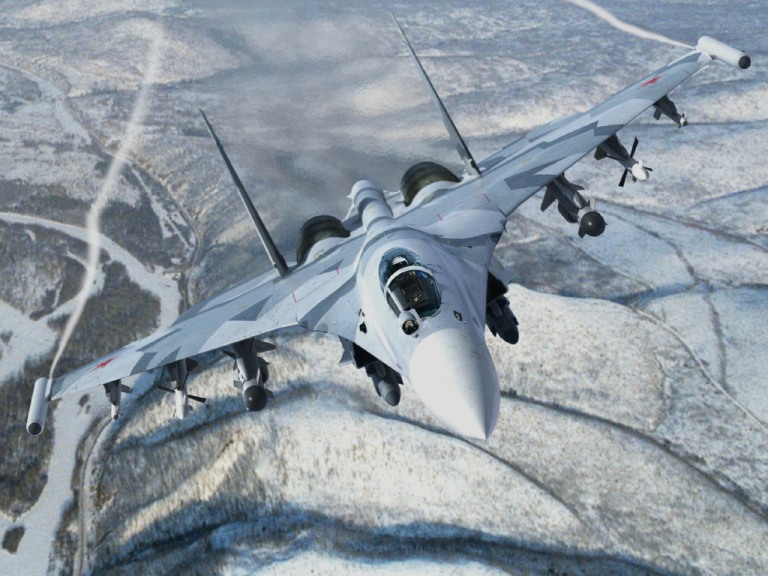 Su-35
Flanker E (KnAAPO).
|
Reports indicating that the Russian Lyulka/Rybinsk Al-41F supersonic cruise engine is entering Low Rate Initial Production, and the recent Defense Acquisition Board decision to transition the supercruising F-22A Raptor to full rate production, illustrate the highly competitive nature of the fighter business. Supersonic cruise will change many aspects of how air superiority is won, and the future question in assessing fighters will inevitably be 'does it have supercruise?' Supersonic cruise or supercruise is a term which refers to the ability of a combat aircraft to sustain supersonic flight without using afterburning thrust. Combat aircraft have had supersonic capability since the 1950s, exploiting afterburners to effectively multiply available thrust and thus overcome the drag rise characteristic of transonic and supersonic flight, as well as improving climb, turn and acceleration performance. The additional thrust advantage of the afterburner comes at a prohibitive price - fuel burn is multiplied severalfold as fuel is injected into the tailpipe and combusted. A byproduct of afterburner use is a dramatic increase in the aircraft's heat signature, the engine plumes becoming effectively an infrared beacon which can be detected and tracked from dozens of miles away. In practical terms conventional gas turbine engines afford only a transient supersonic capability, one which must be used very carefully as it can expend thousands of pounds of fuel in minutes, and advertise the fighter's presence and energy state from tactically very useful distances. Having the ability to sustain supersonic speeds without these drawbacks affords numerous advantages in combat. The first of these is that entering an engagement the supersonic fighter has a reserve of kinetic energy which a subsonic opponent does not have. As a result the supersonic fighter can often dictate the terms of the engagement. More importantly, sustained supersonic speed presents genuine problems in engagement kinematics for an opposing conventional fighter. Even in Beyond Visual Range (BVR) combat, air to air missiles have kinematic limitations. To effect a kill a fighter must position itself so the target falls into a 'no escape zone' for the missile type being used. Unless this precondition is met, the missile will likely run out of energy and be unable to engage the target. In classical intercept geometries, fighters are typically vectored into a head to head closing geometry upon which the player with the earliest firing opportunity, whether afforded by longer radar/missile range, or supporting networking capability, has the advantage. Where both fighters have matched conventional kinematic capabilities, the game well and truly revolves around incremental advantages in missile capability, or situational awareness, provided by onboard or offboard sensors. This delicate balance, and the advantages yielded by incremental imbalances in missile and sensor technology, will collapse once one of the fighters has the capacity to sustain supersonic speeds. As a result, even modest heading changes by the supersonic fighter, when positioning for the engagement, will force the conventional fighter to go into afterburner early, and typically will create enough separation to ruin the conventional fighter's missile shot geometry. In effect, conventional fighters flying against fighters with sustained supersonic capability usually do not get good opportunities for BVR missile shots. Only a very significant advantage in the kinematic performance of the missiles carried by conventional fighters can offset the advantages held by the player with sustained supersonic capability. The classical case study is the obsolete Cold War MiG-25 Foxbat, used in reconnaissance, interceptor and defence suppression roles. Capable of sustaining Mach 1.8 class speeds even with external stores, the aircraft proved extremely difficult to engage during the 1991 Desert Storm campaign - the only case study we have of an air battle involving BVR combat and top tier conventional fighters such as the F-15C and F-14 series. While the US and Israelis have successfully killed Foxbats on numerous occasions, invariably this involved carefully setting up an engagement against a target behaving predictably. The reality is that the situational awareness advantages afforded by modern ISR and networking capabilities only work where the fighters using them have kinematic parity with their opponents. Once the opposing fighter has a significant kinematic advantage, the tables may well be turned. Given that most modern fighter fleet operators have AEW&C capabilities, or are acquiring AEW&C capabilities, the line of argument which presents AEW&C and networking as an air combat panacea is little more than nonsense. The issue of long range Russian 'counter-AWACS' missiles such as the R-172 and R-37 is a consideration in its own right. AEW&C and networking are becoming a common prerequisite, driving the capability contest yet again into other areas - and supersonic cruise will be the next arena in the global competition for air superiority. Achieving genuine supersonic cruise capability hinges on two technological prerequisites. The first is having a powerplant which develops enough dry thrust at altitude to offset supersonic airframe drag. The second is having an airframe design built for low supersonic drag. Unless both conditions are met, supersonic cruise capability is not achievable. The airframe issues dictate a wing design typically with 45 degrees or more of leading edge sweep, and suitable fuselage area ruling. Moreover, weapons must be carried internally or in a semi-conformal or conformal arrangment, to avoid a supersonic drag penalty. Pylon mounted missiles are not the preferred strategy. To date, airframe aerodynamics have not been the obstacle in the supercruise game. Engine capabilities have remained the principal obstacle. A turbofan engine designed for supersonic cruise will be characterised by a much higher turbine inlet temperature than contemporary 'conventional' fighter engines. It is this operating cycle which permits the engine to sustain higher dry thrust ratings at high altitudes. This has also proven to be the primary obstacle to date in building supercruise engines, as it requires advanced materials and advanced turbine cooling techniques. The first service to recognise the importance of supercruise was the US Air Force, which incorporated supercruise into the early requirements definition of the Advanced Tactical Fighter (ATF) program, which eventually coalesced into today's F/A-22A Raptor. An extensive and expensive engine technology research and development effort led to the design of the Pratt and Whitney F119-PW-100 engine which powers the F-22A. Delivering around 35,000 lbf of afterburning thrust, the F119-PW-100 is the most powerful fighter engine manufactured in the Western world. The simplest qualitative measure of the F119-PW-100's performance is that this engine has a dry thrust performance envelope matching the afterburning thrust envelope of the F100-PW-100 series engines fitted to the F-15C/E and many F-16 variants. As a result the F-22A is the only production fighter in existence with a genuine supersonic cruise capability and the enormous kinematic advantages this affords in combat. This analyst had the opportunity to discuss the practical aspects of supercruise capability with one of the F-22A test pilots some years ago. Not only were chase fighters unable to keep up, but in mock intercepts flown by F-16Cs and F-15Cs against development F-22A airframes, even modest 20 degree heading changes caused the teen series fighters to abort their intercepts, having burned their fuel down to bingo levels. 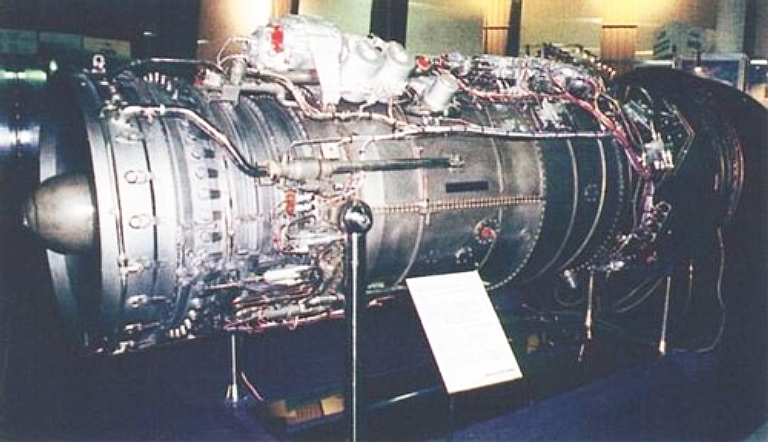 A
derated AL-41F supersonic cruise engine has been trialled in an Su-27S
since 2004.
Russia's Supercruise Program The Soviets recognised the threat presented by the emerging ATF with its supercruise capability and initiated the development of a fifth generation supercruise engine in 1985. The program was awarded to the Lyulka bureau, under the leadership of Viktor Mikhailovich Chepkin. The designation Al-41F or Izdyeliye (Article) 20 was adopted. The design aims for this engine were ambitious - to meet or exceed the performance of the US F119 family of engines. To that effect the Al-41F was to achieve a thrust to weight ratio in excess of 10:1, over the 8:1 ratio characteristic of the Al-31F series developed for the Su-27/T-10 fighters. The engine was to have a reduced number of stages and increased pressure ratio, like the F119. EU sources claim that a turbine inlet temperature increase of 250 degrees C was sought over the Al-31F, pushing the value up to 1600 degrees C. A Full Authority Digital Engine Control (FADEC) was ultimately sought, with the engine controls tightly integrated with the flight controls of the fighter using it. The first flight testing of prototypes was performed at the Gromov Institute in 1990, using a Tu-16LL Badger testbed. Subsequently a MiG-25PD was retrofitted with one of its R-15-300 engines replaced with a Al-41F prototype. Over the subsequent years thirty test flights were performed, before funding constraints slowed the effort down. Development tests demonstrated static afterburning thrust performance claimed to be at 39,600 lbf (176 kN) with 45,000 lbf (200 kN) a design target. These figures exceed cited thrust ratings for the US F119 and F135 family engines. TBO was reported to be an issue with demonstrator engines, with latter development effort being concentrated on achieving similar engine life to the Al-31F. Derating the engine would address this to a large extent, as not every application demands the full performance potential of the Al-41F. The Al-41F was the designated engine for the Su-32/34 Fullback, now entering Low Rate Initial Production (LRIP) for the Russian Air Force. All seven Fullback demonstrators were flown with earlier Al-31F engines due to the then unavailability of pre-production Al-41Fs. The Fullback, designed to fill the niche between the F-15E and F-111, is heavier than the Su-27/30 and required the Al-41F to meet performance targets - the 10-13% better SFC of the Al-41F was also a benefit for this strike fighter. 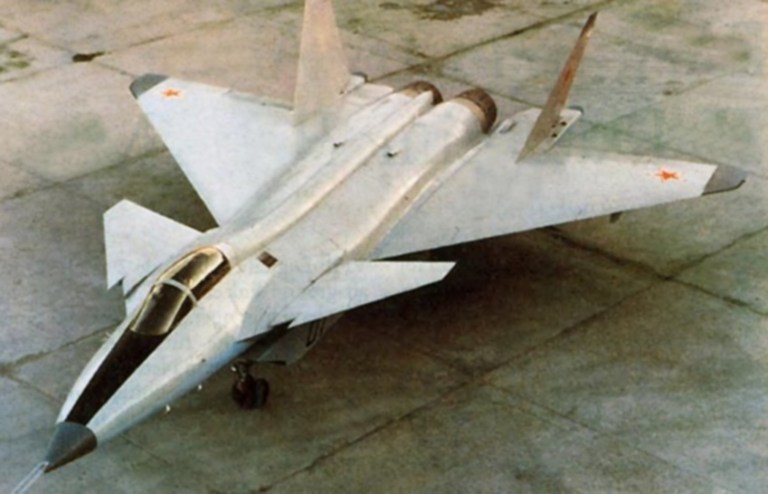 MiG
MFI Prototype (RuMoD).
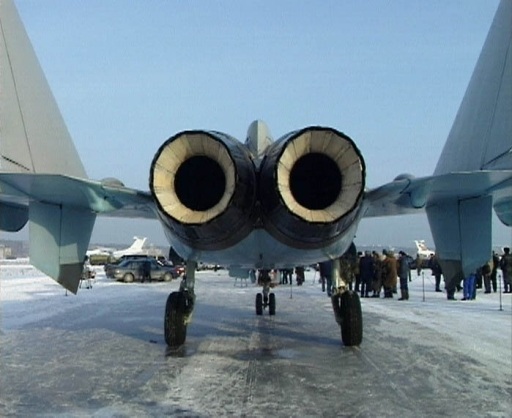 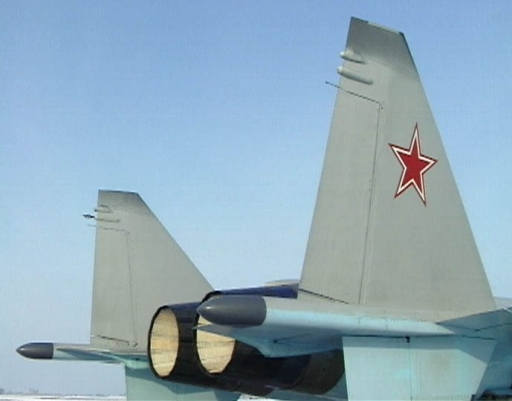 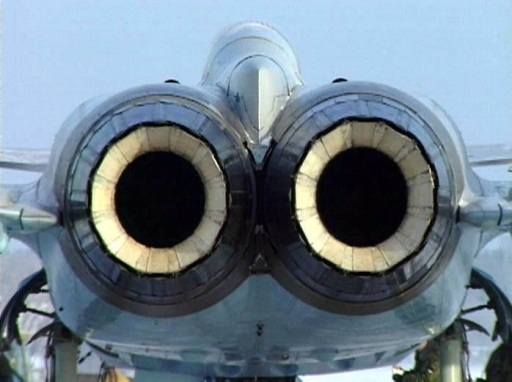 AF-41F in MFI (All images via FAS) The Al-41F did not debut until the 1998 rollout of the stillborn MiG I.42/I.44 MFI (Mnogo-Funktsioniyy Istrebitel') multirole fighter demonstrator - the most notable exposure during this event were photographs showing the ceramic coating inside the Al-41F nozzles. The MFI, designed as a supercruising challenger to the F/A-22A, is claimed to supercruise at Mach 1.8 to 1.9 using a pair of Al-41Fs. The MFI prototype first flew in early 2000. Russian and EU sources claim the MFI's Al-41F engines have 3D thrust vectoring capability. Current indications are that the MFI will remain a demonstrator, with the Sukhoi bureau winning a 2002 tender to develop Russia's new fifth generation fighter. In October 1998, Russian media reports disclosed that Rybinsk Motors was nominated as the production plant for the Al-41F, with a 2 billion Rouble investment program planned over a four year period. A report in the AeroWorldNet journal described the use of composite casing for weight savings, and advanced materials including boron-fibre composites in the engine. The same report claimed that 27 ship sets of the demonstrator Al-41F configuration were built by Saturn/Lyulka in their Moscow facilities to date. Thrust to weight performance for the engine was cited at 11:1, and sustained supercruise speeds of Mach 1.6 to 1.8 were claimed. The first production type to be fitted with the Al-41F will almost certainly be the Su-32/34 Fullback, and the recently initiated LRIP build is likely to provide the revenue base for the current LRIP build of the Al-41F at Rybinsk. The engine variant has been described as the Al-41F1 which has engine mounts and tailpipe sized for the envelope of the existing Al-31F used in Fullback demonstrators and production Su-27/30. What is clear at this stage is that Rybinsk/Lyulka now have a powerplant in the thrust/weight class of the F119 and F135, with an engine cycle suitable for supercruise, and a physical envelope compatible with the existing Al-31F engine series. The implications of this are far reaching. Supercruising the Flanker The ongoing budgetary woes of the Russian government present a very unclear future for the planned fifth generation Flanker follow-on design, and for the intended light multirole fighter, planned as a competitor to the Joint Strike Fighter. Both of these designs are unlikely to materialise as production items until 2020, assuming they do not disappear down similar budgetary black holes to that seen with the MFI. What Russia does have now is a top tier fighter engine which is competitive against the F119 in performance, and an investment bill shared between the government, Lyulka/Saturn and Rybinsk, which requires return on investment. It is likely that the Sukhoi Su-32/34 Fullback will be exported to China, and possibly India, but the production numbers of this capable strike fighter remain unclear. While it offers significant performance gains over the Su-30MK strike fighter, it is also a new design with unique avionics, systems and airframe. In effect the greatest competitor the Su-32/34 has in the market is the existing Su-30MK. For Russia to recoup the investment made in the development of the Al-41F, hundreds of engines will need to be exported for hard cash. Indeed, reports that the Al-41F core is to be used for a commercial fan indicate that pressure will exist to fund this further development, and export sales of the Al-31F have to date been at the heart of Lyulka/Saturn's success. The clear candidate for high volume exports of the Al-41F near term is the Sukhoi Flanker. With China now flying around 280 Flankers and planning at least 380 airframes, India planning at least 180 airframes, and Russia still operating several hundred, plus some regiments of newer Su-35, the potential market for retrofit sales is considerable. What the Al-41F would provide the Flanker with is unmatched thrust/weight ratio in its class, and stores carriage permitting, significant gains in supersonic persistence. It is no overstatement to observe that an Al-41F equipped Flanker will provide F/A-22A class kinematic performance, even if its supercruise endurance may be lower due to less refined Mach 1.5 range aerodynamic design and external stores carriage. With typical combat weights around 46,000 lb, late model Flankers equipped with a baseline Al-41F would have a staggering wet static combat thrust to weight ratio of 1.7:1 or about 60% greater than figures for evolved third generation Western fighters, or the new Joint Strike Fighter. Even a derated Al-41F built for durability would provide a decisive advantage to the Flanker in climb, acceleration and sustained turn performance. The principal issue in adapting the Flanker for supercruise will be reduction of external stores drag. All Flanker variants carry stores on wing pylons, inlet tunnel stations, and fuselage tunnel stations. A design devised for the Fullback was a conformal stores pod which was installed into the fuselage tunnel. The adaptation of this design for internal or semiconformal carriage of the R-77 and R-73 series missiles is not an unusually difficult task, although supersonic stores ejection may present some clearance issues. A payload of six to eight AAMs in such a conformal stores pod is feasible, with a clean wing, and well matched to an air superiority role. The advent of the Al-41F engine on the Flanker is arguably only a matter of time now. Once this occurs, supercruising Flankers will have a performance envelope not unlike the F/A-22A, putting them kinematically well outside the reach of legacy teen series fighters, the Eurocanards, and the Joint Strike Fighter. If Australia does commit to the Joint Strike Fighter and or F/A-18E/F rather than the F-22A, as an F/A-18A replacement, the certainty is now that it will end up with an aircraft wholly uncompetitive in the brave new world of supersonic cruise dominated air combat. |
Imagery Sources: RuMoD, KnAAPO Line Artwork: © 2005, 2007 Carlo Kopp |
|
|||||||||||||
![Sukhoi PAK-FA and Flanker Index Page [Click for more ...]](APA/flanker.png) |
![F-35 Joint Strike Fighter Index Page [Click for more ...]](APA/jsf.png) |
![Weapons Technology Index Page [Click for more ...]](APA/weps.png) |
![News and Media Related Material Index Page [Click for more ...]](APA/media.png) |
||||||||||
![Surface to Air Missile Systems / Integrated Air Defence Systems Index Page [Click for more ...]](APA/sams-iads.png) |
![Ballistic Missiles and Missile Defence Page [Click for more ...]](APA/msls-bmd.png) |
![Air Power and National Military Strategy Index Page [Click for more ...]](APA/strategy.png) |
![Military Aviation Historical Topics Index Page [Click for more ...]](APA/history.png)
|
![Information Warfare / Operations and Electronic Warfare Index Page [Click for more ...]](APA/iw.png) |
![Systems and Basic Technology Index Page [Click for more ...]](APA/technology.png) |
![Related Links Index Page [Click for more ...]](APA/links.png) |
|||||||
![Homepage of Australia's First Online Journal Covering Air Power Issues (ISSN 1832-2433) [Click for more ...]](APA/apa-analyses.png) |
|||||||||||||
| Artwork, graphic design, layout and text © 2004 - 2014 Carlo Kopp; Text © 2004 - 2014 Peter Goon; All rights reserved. Recommended browsers. Contact webmaster. Site navigation hints. Current hot topics. | |||||||||||||
|
Site Update
Status:
$Revision: 1.753 $
Site History: Notices
and
Updates / NLA Pandora Archive
|
|||||||||||||
|
|
Tweet | Follow @APA_Updates | |||||||||||
|
|
|||||||||||||
|
|
|||||||||||||
![F-111 Aardvark Index Page [Click for more ...]](APA/f-111.png)
![F/A-18 Hornet and Super Hornet Index Page [Click for more ...]](APA/fa-18a.png)
![Aerial Refuelling and Airlift Capabilities Index Page [Click for more ...]](APA/aar-lift.png)
![Directed Energy Weapons and Electromagnetic Bombs Index Page [Click for more ...]](APA/dew.png)
![Notices and Updates Index Page [Click for more ...]](APA/notices-128.png)
![APA NOTAM and Media Release Index Page [Click for more ...]](APA/notams-128.png)
![APA Research Activities and Policy / Technical Reports Index [Click for more ...]](APA/research-128.png)
![Search Air Power Australia Website [Click for more ...]](APA/search-128.png)
![Briefings and Submissions - Air Power Australia [Click for more ...]](APA/briefs-128.png)
![Air Power Australia Contacts [Click for more ...]](APA/contacts-128.png)
![Funding Air Power Australia [Click for more ...]](APA/funding-258.png)